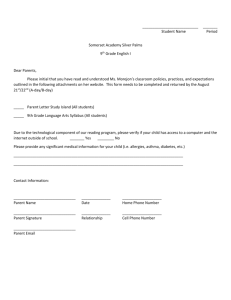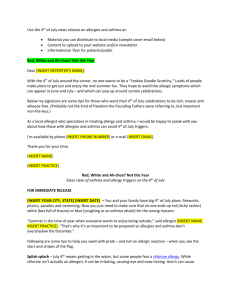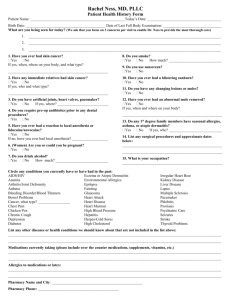Community Outreach Guide - American College of Allergy, Asthma
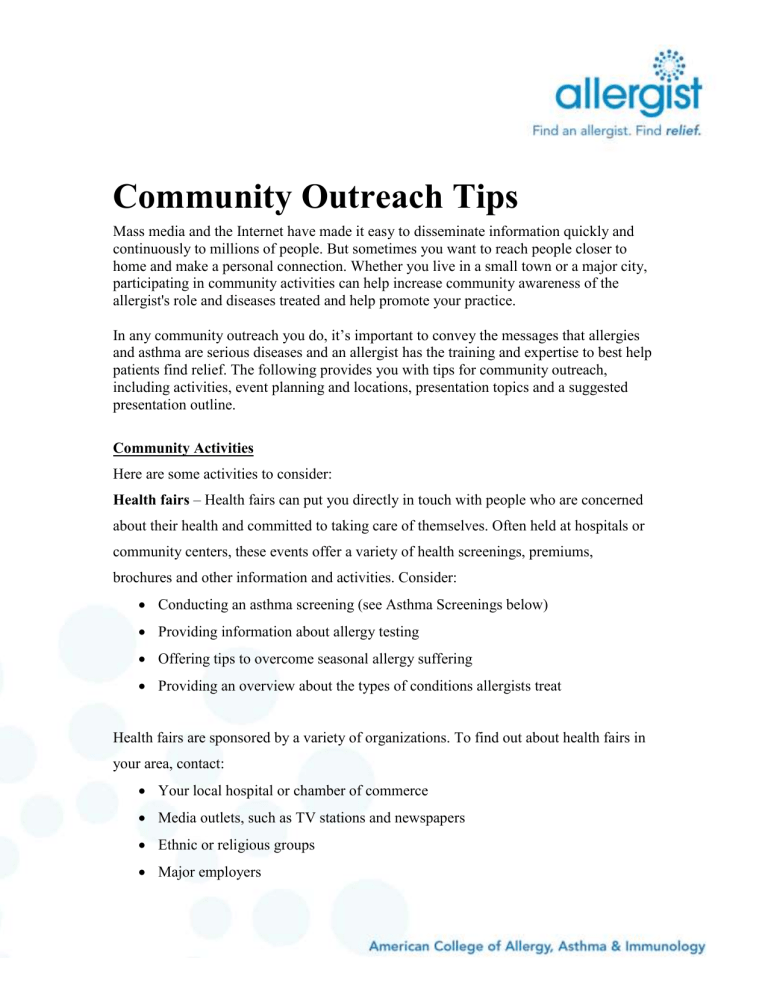
Community Outreach Tips
Mass media and the Internet have made it easy to disseminate information quickly and continuously to millions of people. But sometimes you want to reach people closer to home and make a personal connection. Whether you live in a small town or a major city, participating in community activities can help increase community awareness of the allergist's role and diseases treated and help promote your practice.
In any community outreach you do, it’s important to convey the messages that allergies and asthma are serious diseases and an allergist has the training and expertise to best help patients find relief. The following provides you with tips for community outreach, including activities, event planning and locations, presentation topics and a suggested presentation outline.
Community Activities
Here are some activities to consider:
Health fairs – Health fairs can put you directly in touch with people who are concerned about their health and committed to taking care of themselves. Often held at hospitals or community centers, these events offer a variety of health screenings, premiums, brochures and other information and activities. Consider:
Conducting an asthma screening (see Asthma Screenings below)
Providing information about allergy testing
Offering tips to overcome seasonal allergy suffering
Providing an overview about the types of conditions allergists treat
Health fairs are sponsored by a variety of organizations. To find out about health fairs in your area, contact:
Your local hospital or chamber of commerce
Media outlets, such as TV stations and newspapers
Ethnic or religious groups
Major employers
Your city government, chamber of commerce or a newcomers club often can provide information on local organizations you can approach.
Patient workshops – Offering a workshop on an allergic condition or disease can be a good way to engage patients who know they have a disease but are not being treated by an allergist. You also can invite your own patients to attend and encourage them to invite a friend. At the seminar, you can present basic information about the disease and how an allergist approaches treatment. You also can use the workshop to encourage patients who have the same condition to talk to one another and perhaps form a support group. To reach new patients, it’s often best to conduct workshops in a public location rather than your office.
Asthma screenings – The ACAAI provides free public education, registration and publicity materials to allergists who register to take part in the Nationwide Asthma
Screening Program. If you do not currently participate in this program, you might want to consider it; asthma screenings are a great way to encourage community participation and reach people who need help.
By offering an asthma screening in your community, you can reach people who have breathing difficulties but aren’t sure if they have asthma, as well as those who know they have asthma but don’t have the condition under control. To learn about registration deadlines, visit the Member Section of www.acaai.org
, or call (312) 558-1175.
Speaking engagements – Many organizations, such as Lions, Rotary, Kiwanis, women’s organizations, alumni clubs, hospitals and medical centers, welcome presentations from experts on health topics. Making a presentation provides helpful information to members of the community while enabling you to spread the word about allergists. Suggestions for possible presentation topics and an outline of a sample presentation follow.
Youth clubs/youth sports teams – Children are at high risk for allergies and asthma, and sponsoring a club or team, or volunteering to help, is a good way to reach both children and their parents with information. This also provides a way to educate coaches and club leaders about allergic diseases and what to know about helping a child manage the disease.
School career days – You can start answering the question, “What does an allergist do?” for young people by participating in school career days. It may be helpful to prepare a short handout written in kid-friendly language that lists some of the diseases an allergist treats and describes how allergists help people of all ages. Or you could draft a simple quiz. Props and visuals are helpful when talking to young audiences; you might demonstrate peak flow meters so they can see how lung function is measured or bring pictures of common allergens. Your talk can focus on your work and how you help people, explaining why you became an allergist and describing your training and day-today activities. Or the presentation can be more about allergic conditions.
College student mentoring – Contact your local university or community college’s career placement center to find out about opportunities to mentor students who may be considering a career in medicine, nursing, allied health, communications or business.
Students studying for a career in medicine may not be aware of the allergy, asthma and immunology specialty. Although they may decide to study another specialty, they can still spread the word about allergists to other medical professionals and patients in their future careers. You can offer internships or part-time positions to students who can help you develop community outreach activities, create a Web site, or assist with other community outreach programs. The students benefit by gaining professional experience while you can receive help for a relatively low cost.
Boards of community organizations – By volunteering to serve on the board of a community organization, you can raise awareness of both the allergist specialty and your practice. These organizations can help you meet other community leaders who may mention you to clients, friends and family members. You also can approach organizations like Lions, Rotary, Kiwanis, women’s organizations or alumni clubs, and offer to provide a presentation or asthma screening.
Liaison with area employers – As healthcare costs climb, employers are increasingly interested in keeping their workforce healthy and on the job, and controlling their insurance costs. You can approach the human resource department of a company to offer a lunch-time presentation on an allergy or asthma topic, or participate in a workplace health fair or asthma screening.
Patient support groups activities – Several national organizations, including Allergy and Asthma Network Mothers of Asthmatics (AANMA), the Asthma and Allergy
Foundation of America (AAFA) and the American Lung Association (ALA), have local chapters that offer community activities. They also may have local newsletters.
Volunteering to work with these groups can help promote the message to the community that allergies and asthma are serious, but treatable, conditions. It also can help you meet patients who have the diseases you treat.
Staff ideas – Talk to your staff about their community organizations. They may be able to offer ideas and opportunities to work with the groups they belong to.
Community Events – Locations and Things to Consider
If you are planning a community event and deciding on a location, you should consider the following factors:
How many people do you expect will attend?
Do you need a quiet place (for a presentation), or do you want visibility and foot traffic (for an asthma screening program)?
How long is your event or presentation? Will people need chairs?
Do you need supplies like a table, projector or screen?
Do you need access to electricity (for a computer slide show or a spirometer)?
Whom are you trying to reach? Children? Parents? People who know they have allergies and/or asthma, or people who are undiagnosed?
Here are some locations that might work well for conducting community outreach and may be able to supply some of the things you need (tables, chairs, small rooms, etc.) for little or no cost:
Public libraries
Houses of worship/faith community buildings
Senior centers
YMCAs/local health clubs
Park districts
Cultural centers (be sensitive to any language barriers)
Local hospitals
Store events and shopping malls – Local stores and malls sometimes offer special events for customers to learn about healthy living. You can approach managers at health food stores, toy stores and other shops to see if any of these are scheduled.
Malls provide built-in audiences because of the foot traffic.
Possible Presentation Topics
Here are some ideas that could be used for a presentation, patient seminar or other outreach event:
Spring allergies
Asthma
Holiday allergies
Food allergies
Eye allergies
Sleep Disordered Breathing
Pet allergies
Indoor allergy avoidance
Severe allergy management
Allergies and asthma in children
Asthma and pregnancy
Allergies in women
Allergy shots
Exercise and asthma
Asthma and very young children
Back to school allergy and asthma tips
Insect sting allergies
Skin allergies, eczema and hives
Sample Outline for Presentation on Spring Allergies
I.
Introduction a.
What are spring allergies? i.
Allergies are an over-reaction to something that doesn’t bother most people. ii.
Many people with allergies suffer from them in the spring because they are allergic to the things that grow and bloom during that season. b.
Who gets spring allergies i.
Anyone can get spring allergies. ii.
They can begin at any age. c.
Common spring allergy triggers i.
Tree pollen ii.
Mold iii.
Grass iv.
Other common triggers d.
Common symptoms i.
Sneezing ii.
Runny nose/post nasal drip iii.
Sore throat iv.
Difficulty sleeping/fatigue v.
Itchy, watery eyes
II.
Coping with spring allergies a.
Tips to avoid allergens i.
Keep windows shut. ii.
Shower after coming inside. iii.
Do outside chores on days when pollen counts are low. iv.
Keep your house clean.
b.
Medications i.
Over-the-counter medications ii.
Prescription medications, nasal sprays c.
Allergy shots i.
How they work ii.
Who are candidates?
III.
What is an allergist? How can an allergist help? a.
By finding the source of your suffering i.
Allergy testing ii.
Keeping track of your symptoms and triggers b.
By offering treatments to deal with both symptoms and the source of the suffering
The most important part of giving a community presentation is to understand your audience. If your experience with presentations is mostly with other medical professionals, you’ll need to remember to talk like a layman, avoiding technical terms and the jargon of your profession. Perhaps the best way to think of your audience is as someone you’ve met at a social gathering who wants to learn about your work.
When creating a presentation on any topic, keep these tips in mind:
Use a Power Point presentation or note cards. Do not write and read a “speech.”
Weave examples and people stories into your presentation to illustrate your points and help your audience relate to your messages.
Use visuals – pictures of allergens, people with their allergist, simple illustrations.
Cartoons work well in Power Point presentations. Avoid technical or graphic
photos or illustrations.
Practice and time your presentation. Make sure you leave time for questions.
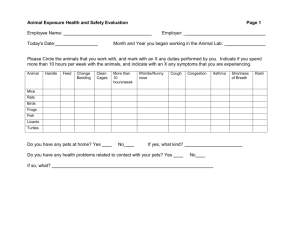
![Pediatric Health Histroy.Initial child.d[...]](http://s3.studylib.net/store/data/006593866_1-7ecae25d724665d2a564380f86b41e96-300x300.png)
